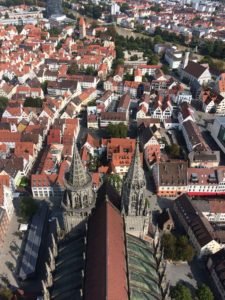
By Alisha Pabon, Stuttgart High School
Special to The Stuttgart Citizen
Traveling around Europe is one of the many benefits to living in the Stuttgart community, and an excellent opportunity for a quick trip is located just south of Stuttgart in the city of Ulm.
Ulm is easily accessible with trains, buses, and cars. During the hour and a half journey from Stuttgart, the scenery is filled with rolling hills and forest.
Once in the heart of the city, a convenient parking garage for Ulm’s city hall is easily accessible (two euros for four hours). The location is ideal, with a quick walk into the Ulm Münsterplatz (town square). Founded in the medieval times next to the longest river in Germany, the Danube, this town has an abundance of history.

As is typical with most German towns, Ulm has a cathedral — but with a twist. Ulmer Münster, located in the center of town, is a grand church built in 1377, making it more than 600 years old. Standing at 161.5 meters (510 feet), it is Germany’s tallest church and has the world’s tallest steeple, according to the Ulmer Münster website. Once you enter, high ceilings and stunning stained glass details welcome you. As people finish walking through the first level, where height is not a factor, there is a chance to climb up to the top. There are 768 stairs to climb up to the highest point of the church, and around 500 stairs to the second highest point. The staircases have windows to peek out of and the views get increasingly better the higher you climb.
After climbing the cathedral, you might be ready to grab a bite to eat or go shopping. The town square has shops, restaurants, and cafes. Diverse restaurants add an interesting touch to Ulm with Egyptian, Japanese, Spanish and German cuisine.
Must-see tourist sites include strolling along the old city wall by the Danube; visiting the Ulm town hall, which is painted with an early renaissance flair and has fascinating details that capture your full attention; and exploring the old fisherman/tanner’s quarters situated next to where the River Blue and the Danube merge together.
According to the Ulm information center, an area once known for artisans now has diverse shops, restaurants and the “Schiefes Haus” a leaning house dating back to 1406 that is featured in the Guinness world of records as the most crooked hotel to stay in.
For those interested in history and art, Ulm has 13 different museums to visit. For instance, the “Brotkultur” museum encompasses history through bread; the Ulm museum showcases the history of Ulm; the Edward Scharff museum displays a variety of artworks created using different mediums; the art gallery Weishaupt has a collection of modern and contemporary art, while “Mr. Zopf’s Friseurmuseum” focuses on the history of hairdressing!
You might witness the “Ulmer Schachtel,” a small boat that 30 men sail down the Danube following a century of tradition for the merchants who traveled the river back in the day. The selectivity of the boat crew is fierce with only locals being able to participate. But don’t fret, there is a solution for everyone: The historical “Ulmer Spatz,” a boat built in 1935 that navigates down the river for 55 minutes. The cost is nine euros for adults and six euros for kids.
Other unique events are the medieval Christmas markets, the Ulm Christmas markets, and the international Danube festival where different cultures come together. Some markets have traditional music, dance, and literature. More cultural events can be found here.
For more information regarding prices and booking, go to: http://www.tourismus.ulm.de (English available).
Editor’s Note: Alisha Pabon is a senior at Stuttgart High School and is a part of the Career Practicum program for the garrison Public Affairs office. She is interested in majoring journalism and communications.






